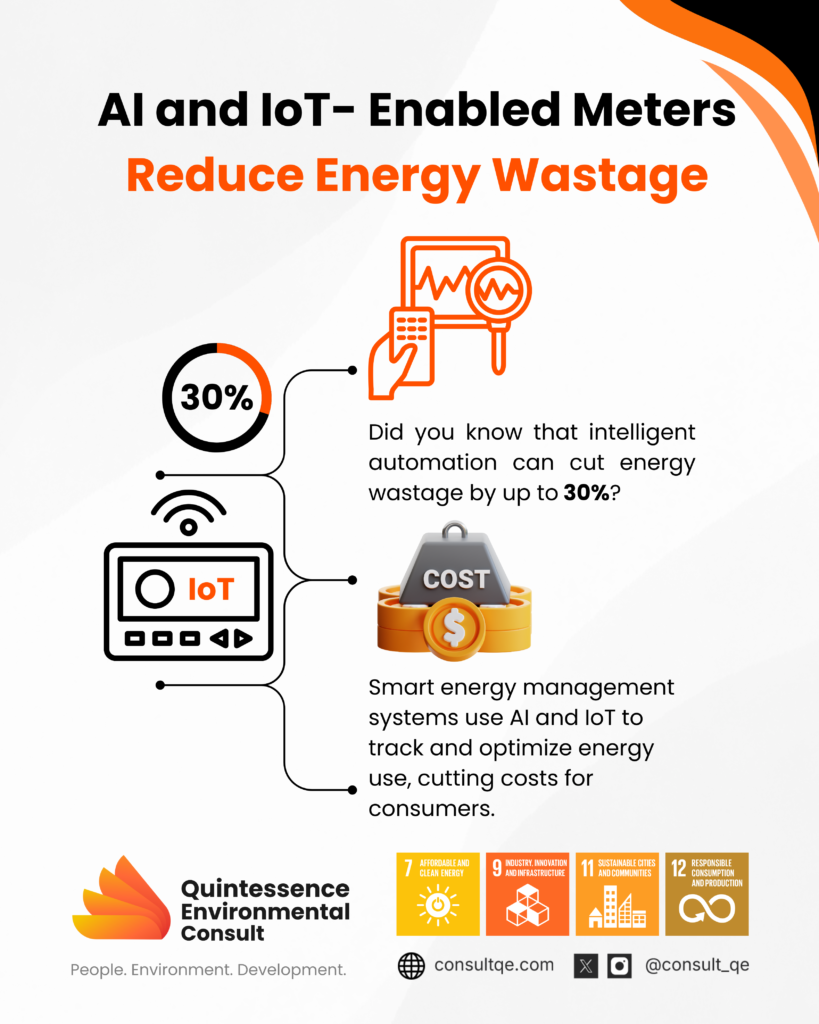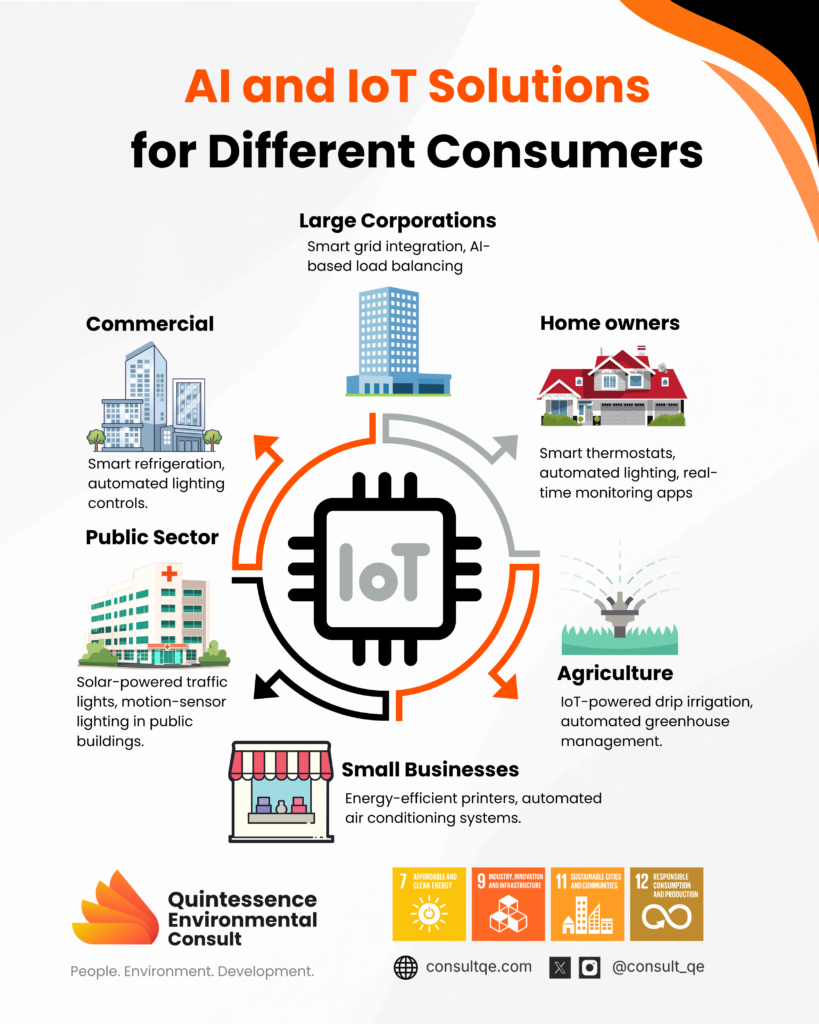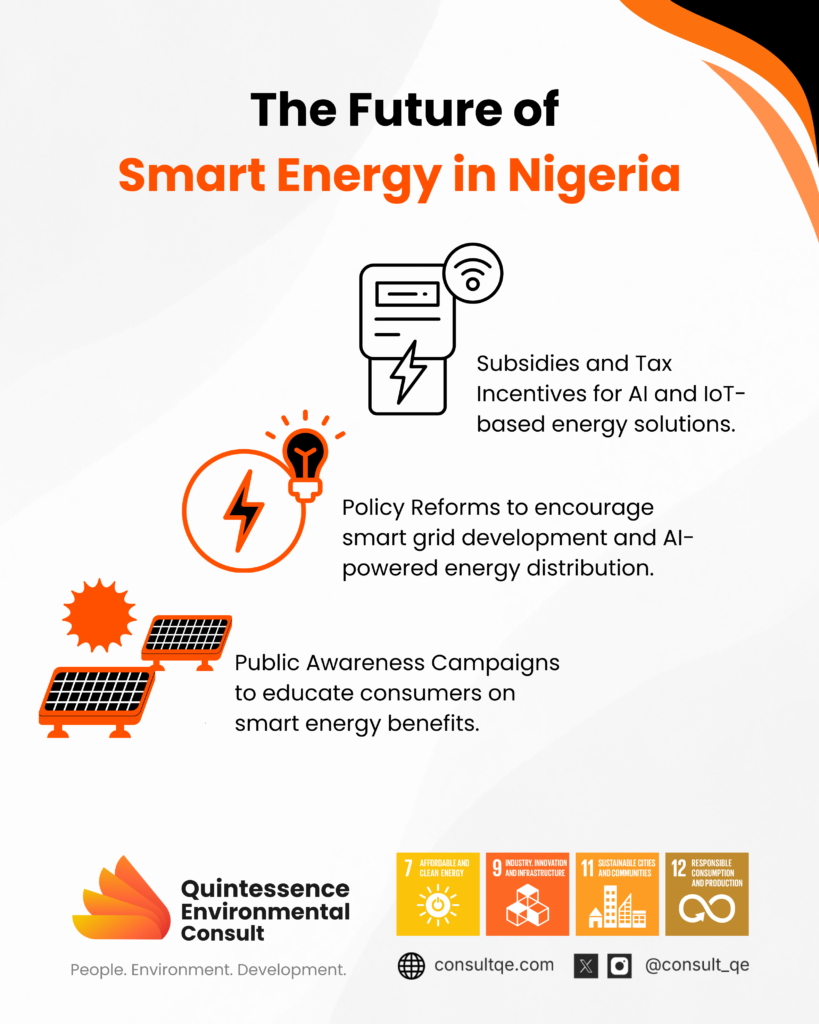Takeaways:
- AI and IoT-Enabled Meters Reduce Energy Wastage: Smart energy management systems use AI and IoT to track and optimize energy use, cutting costs for consumers.
- Real-Time Monitoring Saves Money: IoT-enabled smart meters can help Nigerian households and businesses monitor and reduce electricity consumption.
- Improved Grid Stability: AI-driven energy distribution can help reduce blackouts and improve the reliability of Nigeria’s power grid.
- Smart Energy Is the Future: As AI and IoT adoption grows, integrating these technologies into Nigeria’s energy sector can enhance sustainability and economic efficiency.
Did you know that intelligent automation can cut energy waste by up to 30%? Amid rising electricity tariffs and persistent grid instability, adopting Artificial Intelligence (AI) and the Internet of Things (IoT) for energy efficiency is no longer an option—it’s a necessity for Nigeria.
In Nigerian homes and businesses, energy bills are soaring, with Band A customers (those with 20 + hours of daily electricity access) paying up to ₦209.5 per kilowatt-hour (kWh) (NERC, 2024). For many, this electricity cost per kWh is unsustainable. However, individuals and businesses can track, analyze, and reduce their power consumption through AI-driven energy optimisation and IoT-enabled smart meters. These technologies ensure that every watt counts, significantly lowering electricity costs and enhancing grid stability by reducing the energy demand on the national grid.
The Rising Cost of Energy in Nigeria: A Call for Smarter Solutions
Energy prices in Nigeria are driven by factors such as currency devaluation, rising fossil fuel prices and reliance on outdated infrastructure. Many small and medium-sized enterprises (SMEs) still rely on inefficient energy sources like diesel generators, which are costly and environmentally harmful.
According to the International Energy Agency (IEA), AI-driven energy efficiency solutions could reduce global energy demand by 40% by 2040. For Nigeria, this presents an opportunity to alleviate energy poverty while maximizing existing resources.
Benefits of AI and IoT: Energy Consumption
Globally, AI and IoT have demonstrated transformative potential in energy optimization. In Nigeria, these technologies align with national energy security objectives and multiple Sustainable Development Goals (SDGs):
- AI-Driven Energy Optimization
AI-powered analytics can predict energy usage patterns and automate power distribution. Businesses and homes using smart energy systems powered by AI can:
- Reduce electricity waste by identifying inefficient appliances. (Supports SDG 7: Affordable and Clean Energy, SDG 12: Responsible Consumption and Production)
- Automate power usage based on demand, reducing unnecessary consumption. (SDG 9: Industry, Innovation, and Infrastructure)
- Predict peak demand periods and adjust energy usage accordingly.
- Enhance energy storage efficiency by optimizing battery charging cycles. (SDG 13: Climate Action)
- Improve fault detection in electrical networks and prevent system failures. (SDG 11: Sustainable Cities and Communities)
- IoT-Enabled Smart Energy Management
IoT sensors and smart meters provide real-time data on power consumption, helping consumers make informed decisions. Benefits include:
- Remote Monitoring: Homeowners and businesses can track their energy usage via mobile apps.
- Automated Power Adjustments: Smart thermostats and lighting systems adjust based on usage patterns.
- Fault Detection: IoT-enabled systems can detect faulty appliances that waste energy.
- Grid Load Balancing: Smart meters can communicate with the power grid, helping utilities distribute electricity efficiently. (SDG 7)
- Demand Response Systems: AI and IoT can help regulate energy consumption during peak hours.

Case Studies: Global and Local Applications
Globally, AI-powered smart energy grids have been adopted to enhance efficiency. Some successful implementations include:
- Kenya’s Smart Metering Project: Kenya Power adopted AI-driven smart metering systems across the country. The system uses advanced metering infrastructure (AMI) that sends real-time data to the utility about power usage, which allows for immediate detection of anomalies or irregularities, such as power theft.
- India’s AI-Powered Grid Management: The Indian government, in collaboration with energy providers like the Power Grid Corporation of India (PGCIL), deployed an AI-based grid management system. The system uses machine learning algorithms to analyze historical grid data and real-time data from sensors placed throughout the grid.
- South Africa’s IoT-Based Demand Response System: South Africa’s Eskom and various local municipalities began using an Internet of Things (IoT)-based demand response system to manage electricity consumption efficiently. The system integrates AI with IoT sensors placed in homes, businesses, and industrial facilities.
- United States’ Smart Home Integration: U.S. utilities, including Pacific Gas and Electric (PG&E) and Con Edison, have rolled out AI-driven home energy management systems that are integrated with smart home devices, such as thermostats, lighting systems, and appliances, to optimize energy use.
- Germany’s AI-Powered Renewable Energy Forecasting: TenneT, Germany’s energy company, implemented an AI-driven renewable energy forecasting system to improve the integration of intermittent renewable energy sources. The system uses machine learning to predict solar and wind power generation based on weather patterns and historical data. (Supports SDG 13)
In Nigeria, early adopters of smart energy solutions are already seeing results. For example, Nigeria’s Primelink SmartLink Project has demonstrated the potential for technology-driven supply chain transformation. By integrating AI, IoT, and blockchain, the project achieved a 20% reduction in logistics costs and a 30% improvement in delivery reliability. (Lawrence, 2025). Some businesses that have integrated IoT-powered energy tracking systems report up to a 20% reduction in electricity bills (Yahya M.S. et al. 2023).
Table: AI and IoT Solutions for Different Consumer Types in Nigeria
Consumer Type | Smart Energy Solutions | Examples |
Homeowners | Smart meters, AI-powered energy optimization, smart appliances | Smart thermostats, automated lighting, real-time monitoring apps |
Small Businesses (SMEs) | IoT-based energy tracking, smart office equipment | Energy-efficient printers, automated air conditioning systems |
Large Corporations | AI-driven energy analytics, IoT-enabled monitoring | Smart grid integration, AI-based load balancing |
Agriculture | Smart irrigation, solar-powered sensors, AI-driven climate control | IoT-powered drip irrigation and automated greenhouse management (SDG 2: Zero Hunger) |
Retail/Commercial | Smart HVAC systems, AI-powered billing, demand response tech | Smart refrigeration, automated lighting controls |
Public Sector | Smart street lighting, AI-powered grid management | Solar-powered traffic lights, motion-sensor lighting in public buildings |

- High Initial Costs: Smart energy solutions require a significant initial investment.
- Limited Awareness: Many businesses and homeowners are unaware of these technologies.
- Infrastructure Gaps: Nigeria’s digital infrastructure needs improvement for widespread AI and IoT integration.
- Regulatory Hurdles: Policies should be updated to accommodate smart energy innovations.
However, government incentives, private sector investments, and international collaborations could drive large-scale adoption. (Supports SDG 17: Partnerships for the Goals) The Future of Smart Energy in Nigeria The Nigerian government and regulatory bodies should consider:
- Subsidies and Tax Incentives for AI and IoT-based energy solutions.
- Policy Reforms to encourage smart grid development and AI-powered energy distribution.
- Public Awareness Campaigns to educate consumers on smart energy benefits.

Conclusion
AI and IoT present a massive opportunity for Nigeria to improve energy efficiency, reduce costs, and enhance grid stability. By leveraging these technologies, Nigeria can move closer to achieving its energy security and carbon neutrality goals. As energy prices continue to rise, it is time for Nigerian businesses, households, and policymakers to prioritize smart energy solutions. The future of Nigeria’s energy sector depends on how quickly we embrace this digital transformation.
References:
- International Energy Agency. (2021). AI and Energy Efficiency: A Global Perspective.
- Lawrence Attah. (2025). Leveraging supply chain innovations and AI for economic growth.BusinessDay.
- Nigerian Electricity Regulatory Commission (2024). NERC Energy Report.
- Okorie Ifeoma. (2024). Nigeria to establish AI, IoT, blockchain research centres across the six geopolitical zones. Techpoint Africa.
- United Nations Framework Convention on Climate Change. (2022). Nigeria’s Path to Climate Neutrality.
- World Bank. (2020). Nigeria Power Sector Recovery Plan.
- Yahya , M. S., Muhammad , B., Abubakar , M. A., Abdullahi , U. I., & Musa , Z. I. (2023). Implementation of a Real-Time IoT-Based Energy Management System. Journal of Engineering Research and Reports, 25(10), 19–29. https://doi.org/10.9734/jerr/2023/v25i10997
External Links:
- Reduce Energy Costs with Building Automation – CIS Industries
- Powering the future: The energy shift for sustainable AI | World Economic Forum
- Smart Energy Solutions in Power Sector: Overview of the Challenges in Nigeria Perspective | IEEE Conference Publication | IEEE Xplore
- Why a collaborative approach is critical to energy transition in Nigeria — Energy — The Guardian Nigeria News – Nigeria and World News
- Smart Grid Adoption in Africa (IEA)
- The Future of AI and Energy Efficiency | IBM


